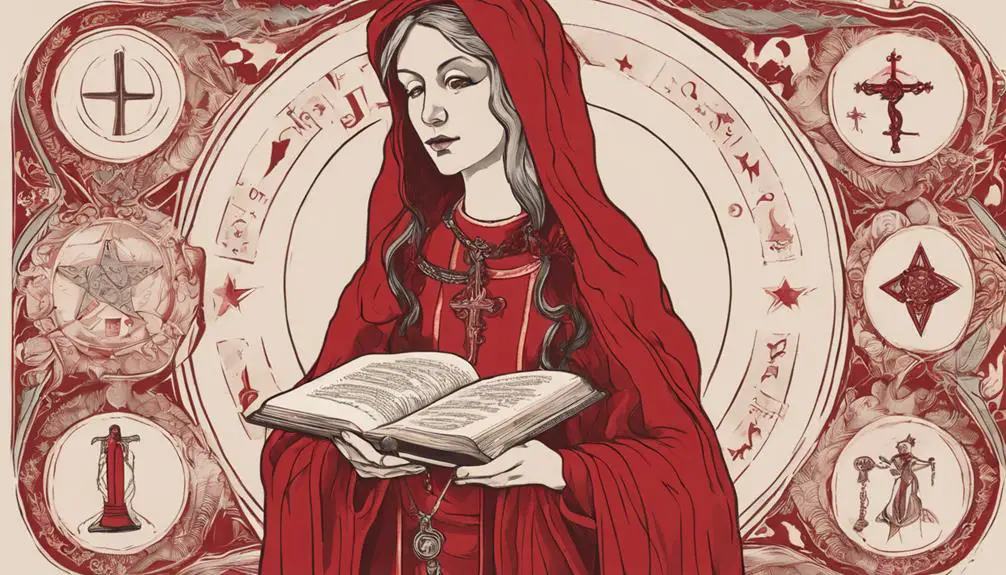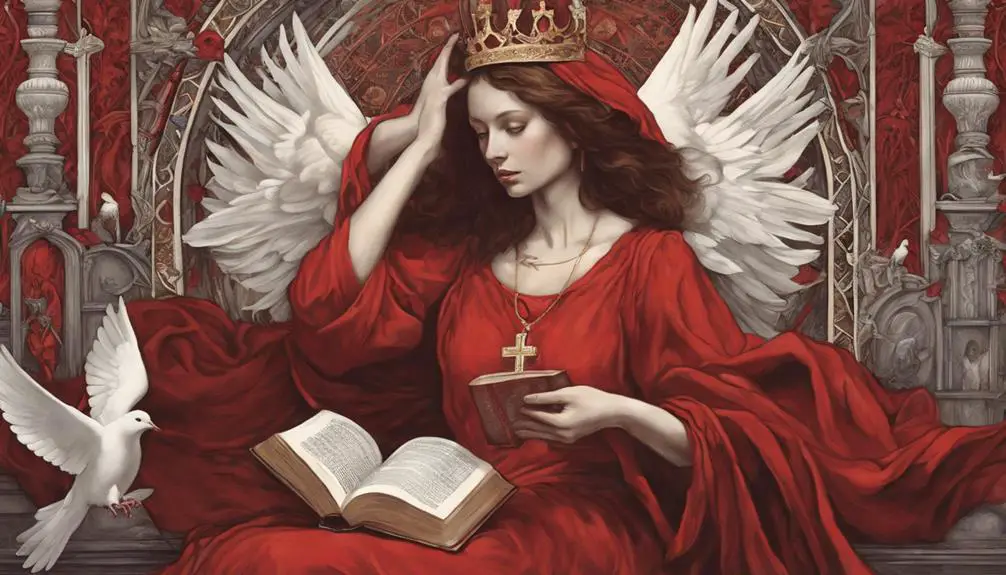Marvel at the mysterious symbolism and intriguing theories surrounding the 'Scarlet Woman' in Revelation 17:4; a biblical enigma waiting to be deciphered.

A Bible Verse About a Scarlet Woman
You're likely familiar with the term 'Scarlet Woman', but did you know it originates from a specific Bible verse, Revelation 17:4?
This verse paints a vivid image of a woman clothed in purple and scarlet, adorned with gold and precious stones, but there's more to this scripture than meets the eye.
Theories abound regarding the woman's identity and the symbolism behind her ornate attire. To fully comprehend the verse's depth, we'll need to explore its historical and cultural context.
Are you ready to further unravel this biblical mystery?
Key Takeaways
- The Scarlet Woman in the Bible symbolizes sin, decadence, and moral corruption, often associated with false religion or idolatry.
- She is depicted in Revelation 17:3-6 as 'Babylon the Great', signifying wealth, power, and sin in an apocalyptic context.
- Interpretations of the Scarlet Woman vary greatly, ranging from sexual immorality to rebellion against patriarchal structures.
- Historically, her image has evolved over time, from a symbol of temptation and immorality to one of rebellion and freedom.
Understanding the Scarlet Woman

Often, you may find yourself perplexed by the biblical references to the Scarlet Woman, a symbol steeped in complex imagery and layered meanings. She's not just a character, but a symbol, an idea, a concept that carries a lot of weight. The term is extracted from passages in the Bible, specifically in the Book of Revelation, where she's depicted in vividly dramatic and cryptic language.
Now, you might ask, why scarlet? In biblical context, scarlet, a deep red color, often symbolizes sin, decadence, or moral corruption. It's used to create a stark contrast against the spiritual purity often represented by white in biblical texts. Thus, the Scarlet Woman embodies the antithesis of purity, a metaphor for spiritual degradation.
The Scarlet Woman is typically portrayed riding a beast, a symbolism thought to represent her dominance over worldly powers. Her image has been used metaphorically to criticize oppressive systems, religious hypocrisy, or moral corruption.
Biblical Verse Context

To fully comprehend the symbolism of the Scarlet Woman, it's crucial to examine the specific biblical verses that mention her. The most notable reference is found in the Book of Revelation, specifically Revelation 17:3-6. John, the writer, describes a vision of a woman dressed in purple and scarlet, bedecked with golden jewels, pearls, and holding a golden cup full of abominations. This woman, identified as 'Babylon the Great', sits atop a beast with seven heads and ten horns.
The narrative context of Revelation is apocalyptic, penned toward the end of the 1st century A.D. during a period of intense Roman persecution. John's audience, early Christians, would have been familiar with the symbolism employed. The colors purple and scarlet, and the opulent jewelry, could symbolize wealth, power, and decadence. The cup, filled with abominations, and the beast, could represent the sinful nature and destructive power of this entity.
Understanding this context is essential to grasp the full meaning of the Scarlet Woman. However, remember that biblical interpretation is often layered and multifaceted, requiring further analysis beyond just the immediate context.
Interpretations of the Verse

Delving into the various interpretations of the verse, you'll find a wealth of scholarly debate and theological discussion centered on the identity and symbolism of the Scarlet Woman. Some scholars interpret her as a representation of a city, often Babylon, seen as a corrupt and immoral entity in biblical texts. Others, however, view her as symbolic of a false church, leading people astray from true faith.
It's important to note that interpretations can be influenced by the cultural and societal contexts of the interpreters. For some, the Scarlet Woman symbolizes sexual immorality or unfaithfulness, drawing on the color's traditional association with sin and temptation. Yet, there's also a feminist reading where she embodies the powerful, independent woman who was seen as a threat to patriarchal structures.
Interpretations of the Scarlet Woman are as diverse as they're complex. You'll find that understanding these varying interpretations not only enriches your viewpoint of this biblical figure but also provides insight into the societal and cultural contexts that shaped these interpretations. You'll be left to ponder, who's the Scarlet Woman to you?
Historical Perspectives

Looking back through history, you'll gain a deeper understanding of how perceptions of the Scarlet Woman have evolved and shifted over time.
In the Early Church, the Scarlet Woman was often associated with immorality and temptation. During the Middle Ages, she was frequently depicted as a dangerous seductress, often in religious art and literature. However, during the Enlightenment, the interpretation of the Scarlet Woman began to shift, with some viewing her as a symbol of rebellion and freedom.
To further illustrate these changing perspectives, consider the following table:
Era |
Common Interpretation |
Notable Examples |
|---|---|---|
Early Church |
Immorality and temptation |
Writings of Church Fathers |
Middle Ages |
Dangerous seductress |
Religious art and literature |
Enlightenment |
Symbol of rebellion and freedom |
Philosophical texts |
Symbolism and Significance

In examining the symbolism and significance of the Scarlet Woman, you'll uncover layers of meaning embedded in this intriguing biblical figure. The term 'Scarlet Woman' often symbolizes a woman of sin, particularly related to sexual immorality, in biblical literature. This is due to the association of the color scarlet with sin and degradation, as evidenced in numerous biblical texts.
Moreover, the Scarlet Woman is frequently linked to the city of Babylon, the epitome of decadence and corruption in the scriptures. You'll observe that Babylon's downfall is often paralleled with the Scarlet Woman's downfall, indicating a moral lesson about the destructive consequences of sin and debauchery.
You'll also find that the Scarlet Woman serves as a symbol of false religion or idolatry in the Bible. She's often depicted as leading people astray from the true path of faith, acting as a potent warning against the dangers of spiritual infidelity.
In essence, the Scarlet Woman is a multi-layered symbol, encapsulating themes of sin, corruption, religious deceit, and moral downfall. Through her, you'll see a vivid portrayal of the consequences of straying from righteousness and the divine path.
Conclusion
You've explored the biblical verse regarding the scarlet woman, delving into its context, interpretations, and historical perspectives. You've uncovered its symbolic significance, shedding light on this enigmatic figure. By doing so, you've deepened your understanding of biblical literature, and perhaps, challenged your preconceptions.
Continue this journey, as each verse opens new realms of wisdom and insight. Remember, interpretation is a personal journey, colored by your unique experiences and beliefs.



Sign up